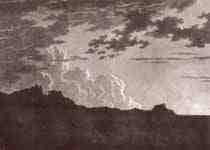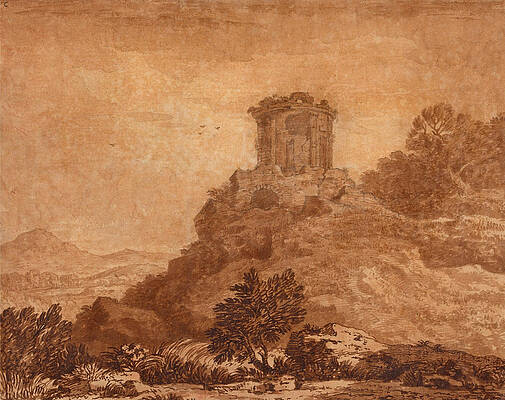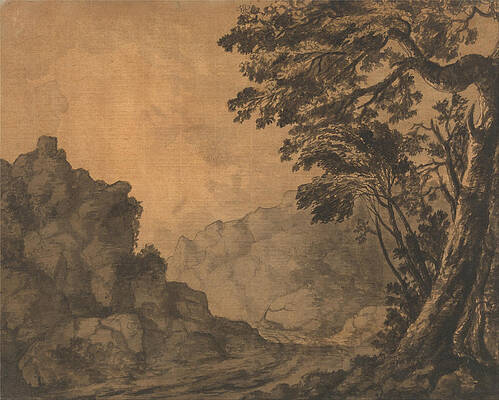Alexander Cozens
Drawings
River and Boat
Landscape with a Ruined Temple
A Road in a Mountain Landscape with Trees to the Right
Coastal Scene with Wooded Cliff

Fine Art Prints | Greeting Cards | Phone Cases | Lifestyle | Face Masks | Men's , Women' Apparel | Home Decor | jigsaw puzzles | Notebooks | Tapestries | ...
Close of the Day. Sunset on the Coast
Alexander Cozens (1717–1786) was a British landscape painter in watercolours, born in Russia. He taught drawing and wrote treatises on the subject, evolving a method in which imaginative drawings of landscapes could be worked up from abstract blots on paper. His son was the artist John Robert Cozens. Alexander Cozens was born in St. Petersburg, Russia. Widely believed to be a natural son of Emperor Peter I of Russia and a British woman — Mary Davenport — from Deptford, he was in fact, the son of Richard Cozens (1674–1735), who worked for Peter as a shipbuilder. The emperor was Cozens' godfather. He was educated in England from 1727, but later returned to Russia. In 1746 he sailed from St Petersburg to Italy, where he spent two years before travelling onwards to England. While in Rome he worked in the studio of the French landscape painter, Claude-Joseph Vernet. Between 1750 and 1754, Cozens was drawing-master at Christ's Hospital, and in the same decade also began to take private pupils. From 1763 to 1768 he was drawing-master at Eton College. He gave lessons to the Prince of Wales, Sir George Beaumont, and William Beckford, arguably the three most important British art patrons and collectors of their generation. Beckford continued to correspond with him for some years. He also practised at Bath.
In 1760 he was among the contributors to the first public exhibition in London of works by living artists, held in the great room of the Society of Arts. The exhibition was organised by a body of artists who afterwards divided into the "Free Society" and the "Incorporated Society of Artists". Cozens contributed to the exhibitions of both societies. In 1761 he obtained a prize from the Society of Arts at the exhibition in the Strand of the former, but he was one of the original members of the latter, incorporated in 1766. He also exhibited eight works at the Royal Academy between 1772 and 1781.
He married Juliet Pine, a sister of Robert Edge Pine and daughter of John Pine, Bluemantle Pursuivant in the College of Heralds. They left one son, John Robert Cozens and a daughter Juliet Cozens. Cozens died in Duke Street, Piccadilly, London, on 23 April 1786.[4]
Work
The style used by Cozens before he finally settled in Britain can be seen in a collection of fifty-four early drawings, mostly Italian scenes, in the British Museum. Cozens lost them in Germany on his way from Rome to Britain, and they were only recovered by his son in Florence in 1776. They show him as a highly skilled draughtsman in the style of the time, with a feeling for elegant composition. Some are wholly in pen and ink in the manner of line engravings. Others show extensive landscapes elaborately drawn in pencil, and partly finished in ink. Others are washed in monochrome, and some in colour of a timid kind. In most there is little sky, but in one he has attempted a bold effect of sunlight streaming through cloud, and brightly illuminating several distinct spots in the landscape. There are several broad pencil drawings on greenish paper heightened with white. Altogether these show that by this time Cozens was a well-trained artist who observed nature for himself, and was not without poetical feeling. After his arrival in Britain he appears, from some drawings in the Victoria and Albert Museum, to have adopted a much broader style, aiming at an imposing distribution of masses and large effects of light and shade.[4]
Henry Angelo, who was (like Sir George Beaumont) his pupil at Eton, described Cozens' unusual method of teaching in his Reminiscences:
Cozens dashed out upon several pieces of paper a series of accidental smudges and blots in black, brown, and grey, which being floated on, he impressed again upon other paper, and by the exercise of his fertile imagination, and a certain degree of ingenious coaxing, converted into romantic rocks, woods, towers, steeples, cottages, rivers, fields, and waterfalls. Blue and grey blots formed the mountains, clouds, and skies'. An improvement on this plan was to splash the bottoms of earthenware plates with these blots, and to stamp impressions therefrom on sheets of damped paper.
In 1785 Cozens published a pamphlet on this manner of drawing landscapes from blots, called A New Method of Assisting the Invention in Drawing Original Compositions of Landscape.[4][5] Cozens defined a blot as "a production of chance with a small degree of design" and acknowledged the influence on his ideas of a passage in Leonardo da Vinci's Treatise on Painting, which recommends that artists should look for inspiration in stains or marks on old walls.[6] Joseph Wright of Derby was influenced by Cozens, owned his paintings using his ideas as inspiration for his compositions.[7]
In 1778 Cozens published Principles of Beauty relative to the Human Head (a work "of more ingenuity than value"[4]), with nineteen engravings by Francesco Bartolozzi. The list of subscribers included William Beckford (father of Cozens' pupil William Thomas Beckford), Burke, Garrick, Flaxman, Sir Joshua Reynolds, and other men of culture. In 1782 Thomas Banks exhibited his Head of a Majestic Beauty, composed on Mr.Cozens's principles. Cozens also published The Various Species of Composition in Nature, and The Shape, Skeleton, and Foliage of Thirty-two Species of Trees (1771, reprinted 1786).[4]
Public Collections
British Museum, Londen
See also
John Robert Cozens
References
Jean-Claude Lebensztejn's L'art de la tache: Introduction a la Nouvelle methode d'Alexander Cozens, Paris, 1990, pp. 31sq.
Lyles, Anne; Hamlyn, Robin (1997). English Watercolours from the Oppé Collection. London: Tate Gallery. p. 66.; text online at "Alexander CozensIn the Farnese Gardens, Rome". Tate Gallery. Retrieved 3 July 2012.
Lyles, Anne; Hamlyn, Robin (1997). English Watercolours from the Oppé Collection. London: Tate Gallery. p. 68.
Monkhouse, W. C. (1887). "Cozens, Alexander (d 1786), landscape-painter in water-colours". Dictionary of National Biography Vol. XII. Smith, Elder & Co. Retrieved 2007-10-23.
A transcription of Cozens's New Method is available in Adolph Paul Oppé, Alexander and John Robert Cozens, Cambridge, Mass., 1954, 165-87; in Joshua C. Taylor, ed., Nineteenth-Century Theories of Art, Berkeley/Los Angeles/London, 1987, 63-71; and in Jean-Claude Lebensztejn's L'art de la tache: Introduction a la Nouvelle methode d'Alexander Cozens, Paris, 1990, 467-84 and plates.
Lyles, Anne; Hamlyn, Robin (1997). English Watercolours from the Oppé Collection. London: Tate Gallery. p. 72.
Turner, Christopher. "The Deliberate Accident". The Tate. Retrieved 21 October 2011.[dead link]
Attribution
This article incorporates text from a publication now in the public domain: "Cozens, Alexander". Dictionary of National Biography. London: Smith, Elder & Co. 1885–1900.
Further reading
Kim Sloan, 'Alexander Cozens and Amateurs Drawn to Etch', Print Quarterly, XXVIII, 2011, pp. 405–09.
C. A. Cramer, 'Alexander Cozen's 'New Method': the blot and general nature - painter', in The Art Bulletin; vol. 79, no. 1 (March 1997), 112-129.
K. Sloan, Alexander and John Robert Cozens The Poetry of Landscape (1986)
A. P. Oppe, Alexander and John Robert Cozens (1952)
----
Fine Art Prints | Greeting Cards | Phone Cases | Lifestyle | Face Masks | Men's , Women' Apparel | Home Decor | jigsaw puzzles | Notebooks | Tapestries | ...
----
Artist
A - B - C - D - E - F - G - H - I - J - K - L - M -
N - O - P - Q - R - S - T - U - V - W - X - Y - Z
Retrieved from "http://en.wikipedia.org/"
All text is available under the terms of the GNU Free Documentation License







